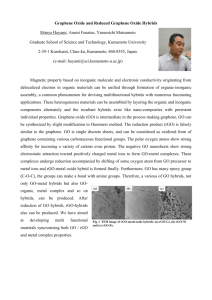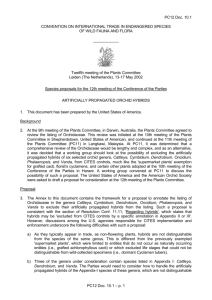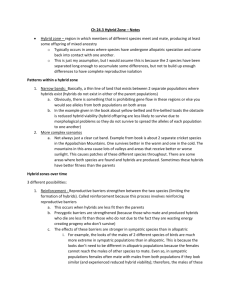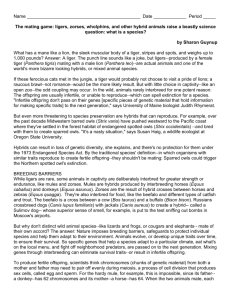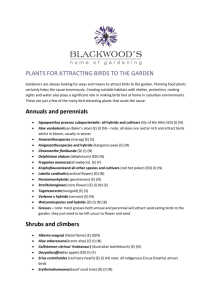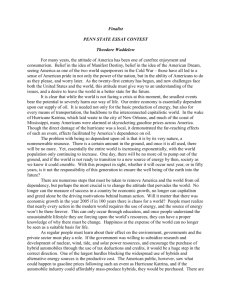Microsoft Word
advertisement
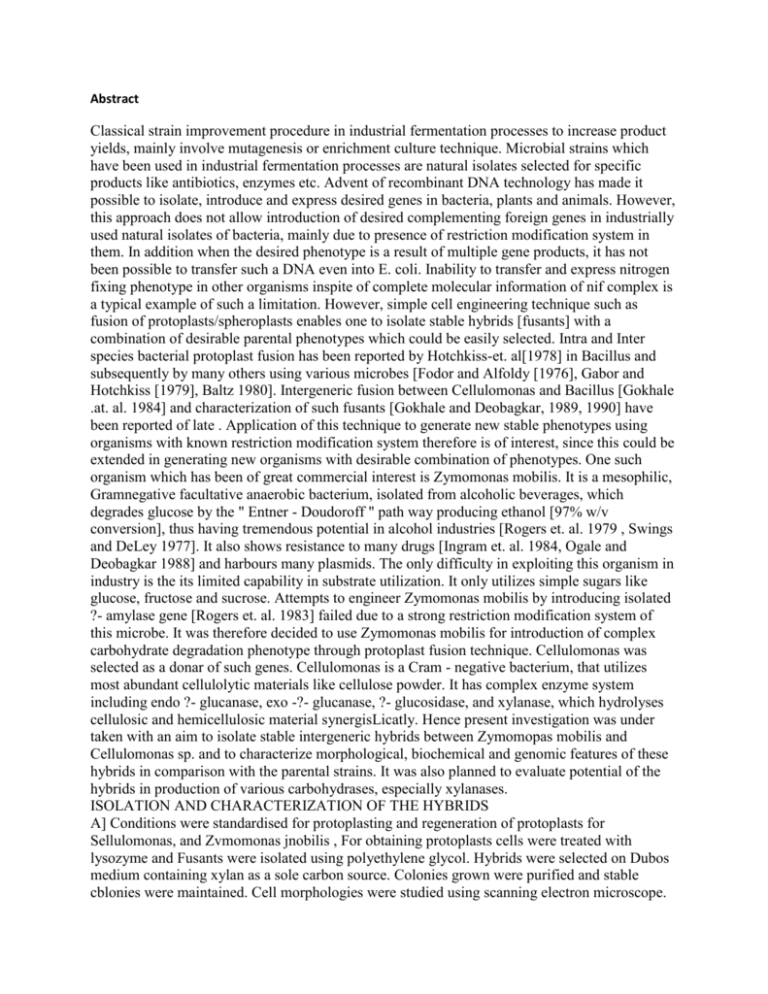
Abstract Classical strain improvement procedure in industrial fermentation processes to increase product yields, mainly involve mutagenesis or enrichment culture technique. Microbial strains which have been used in industrial fermentation processes are natural isolates selected for specific products like antibiotics, enzymes etc. Advent of recombinant DNA technology has made it possible to isolate, introduce and express desired genes in bacteria, plants and animals. However, this approach does not allow introduction of desired complementing foreign genes in industrially used natural isolates of bacteria, mainly due to presence of restriction modification system in them. In addition when the desired phenotype is a result of multiple gene products, it has not been possible to transfer such a DNA even into E. coli. Inability to transfer and express nitrogen fixing phenotype in other organisms inspite of complete molecular information of nif complex is a typical example of such a limitation. However, simple cell engineering technique such as fusion of protoplasts/spheroplasts enables one to isolate stable hybrids [fusants] with a combination of desirable parental phenotypes which could be easily selected. Intra and Inter species bacterial protoplast fusion has been reported by Hotchkiss-et. al[1978] in Bacillus and subsequently by many others using various microbes [Fodor and Alfoldy [1976], Gabor and Hotchkiss [1979], Baltz 1980]. Intergeneric fusion between Cellulomonas and Bacillus [Gokhale .at. al. 1984] and characterization of such fusants [Gokhale and Deobagkar, 1989, 1990] have been reported of late . Application of this technique to generate new stable phenotypes using organisms with known restriction modification system therefore is of interest, since this could be extended in generating new organisms with desirable combination of phenotypes. One such organism which has been of great commercial interest is Zymomonas mobilis. It is a mesophilic, Gramnegative facultative anaerobic bacterium, isolated from alcoholic beverages, which degrades glucose by the " Entner - Doudoroff " path way producing ethanol [97% w/v conversion], thus having tremendous potential in alcohol industries [Rogers et. al. 1979 , Swings and DeLey 1977]. It also shows resistance to many drugs [Ingram et. al. 1984, Ogale and Deobagkar 1988] and harbours many plasmids. The only difficulty in exploiting this organism in industry is the its limited capability in substrate utilization. It only utilizes simple sugars like glucose, fructose and sucrose. Attempts to engineer Zymomonas mobilis by introducing isolated ?- amylase gene [Rogers et. al. 1983] failed due to a strong restriction modification system of this microbe. It was therefore decided to use Zymomonas mobilis for introduction of complex carbohydrate degradation phenotype through protoplast fusion technique. Cellulomonas was selected as a donar of such genes. Cellulomonas is a Cram - negative bacterium, that utilizes most abundant cellulolytic materials like cellulose powder. It has complex enzyme system including endo ?- glucanase, exo -?- glucanase, ?- glucosidase, and xylanase, which hydrolyses cellulosic and hemicellulosic material synergisLicatly. Hence present investigation was under taken with an aim to isolate stable intergeneric hybrids between Zymomopas mobilis and Cellulomonas sp. and to characterize morphological, biochemical and genomic features of these hybrids in comparison with the parental strains. It was also planned to evaluate potential of the hybrids in production of various carbohydrases, especially xylanases. ISOLATION AND CHARACTERIZATION OF THE HYBRIDS A] Conditions were standardised for protoplasting and regeneration of protoplasts for Sellulomonas, and Zvmomonas jnobilis , For obtaining protoplasts cells were treated with lysozyme and Fusants were isolated using polyethylene glycol. Hybrids were selected on Dubos medium containing xylan as a sole carbon source. Colonies grown were purified and stable cblonies were maintained. Cell morphologies were studied using scanning electron microscope. In some hybrids, morphologies similar to Zymomonas were seen while some hydrids showed different morphologies. Twelve such stable hybrids were maintained without selection pressure. They were identified as Zm/C 001, Zm/C 002 Zm/C - 041 --- These hybrids were extensively characterised for their colony morphology, pigment formation, substrate utilisation, enzyme production etc. B] All these isolates exhibited growth on xylan as well as cellulose as a sole carbon source. Extracellular xylanases and cellulases were detected in case of all these hybrids. DMA encoding these enzymes was solely derived from Cellulomonas genome in the hybrids. Optimum pH, temperature and conditions for induction of various gluca?ases by different substrates like starch, xylan, CMC and sugars were studied. Cellobiase and aryl - ?- glucosidase were strictly cell bound in all these cases. Isoenzymes in these categories were separated on a native polyacrylamide gel. In addition to a few identical activity bands in Cellulomonas, these hybrids showed additional enzyme activity bands. In addition, the hybrids harboured plasmids of Zymomonas mobilis origin, and various drug resistance markers of both plasmid and genomic DNA origin were detected. Genomic DNA coded enzymes in Zvmomonas mobilis viz. pyruvate decarboxylase and alcohol dehydroganase were checked as markers and their expression in some of these hybrids was demonstrated. C] Total DNAs isolated from these hybrids were analysed for homology with parental DMAs in dot - blot hybridization. Presence of genomic DNA from both the parents was seen in all these stable hybrids confirming their hybrid status. Using specific genomic clones of alcohol dehydrogenase and pyruvate decarboxylase of Zvmomonas mobilis and ?- amylase [Cellulomonas sp.] in a southern-blot hybridization with genomic DNAs of the hybrids presence of changed environment around these sequences in the hybrids was demonstrated. This observation supported the idea that in these hybrids tWo genomic DNAs of the parent have recombined. No merodiploids ordiploids were found. None of these twelve stable hybrids reverted to either of the parental genotype, even when they were maintained without selection pressure. There were distinct changes in the relative levels of enzyme produced in these hybrids and as compared to the Cellulomonas enzyme, Zm/C 041 produced 10 times more xylanase. This property was further exploited in production of xylanase using immobilized cells. WHOLE CELL IMMOBILIZATION OF Zm/c 041 Hybrid Zm/C 041 cells were immobilized in Calcium alginate gel beads and used for the production of xylanase in batch system. Different parameters like cell load alginate concentration,incubation time and agitation affected the enzyme yield. Under optimized conditions maximum enzyme level with free [7 U/ml] and immobilized [ 30 U/ml] cells were obtained after 48 h. of incubation of 30 C . The gradual decrease in the enzyme level after 48 h. [with immobilized cells] was due to the gradual decrease in the viability of entrapped cells. However xylanase levels obtained with the immobilized system was approximately 3-4 times increased than that produced by free cells. During the course of enzyme production the gels were stable. Results reported in this thesis establish that stable intergeneric hybrids between Zymomonas mobilis and Cellulomonas sp. can be isolated employing protoplast fusion technique. In these hybrids properties of both the parental microbes could be detected and genomes of these hybrids seemed to be recombinants between parental genomic DNAs. Cellulomonas has multiple xylanases and these genes were segregated in the hybrids. Plasmids of Zymomonas mobilis could be stably transfered into the hybrid cells and their markar genes were expressed. Observations also suggest that in nature, appearance of microbes with new phenotypes could be generated through unconventional transfer of genomic information between unrelated bacteria. These studies have generated reagents that could be used in approaching a number of basic questions in microbial evolution and basic molecular biology. Changed beneficial phenotypes of stable intergeneric hybrids could be exploited in biotechnological applications. This technique might also be used in transfering cloned fully characterised genes in E. coli to other desired, industrially useful microbes.
